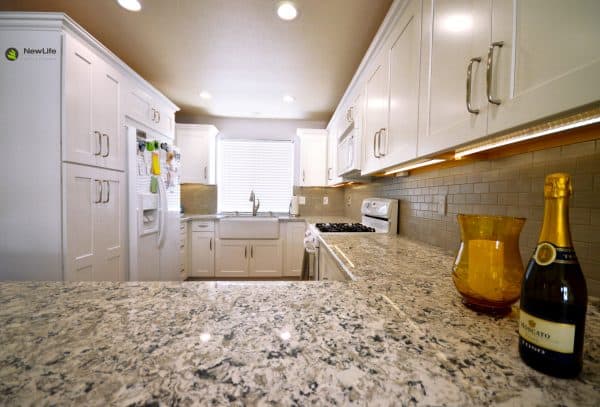How Smart Lighting Can Support Sleep, Safety, and Well-Being for Older Adults

Lighting plays a bigger role in aging in place than most of us realize. With the right setup, smart lighting can make it easier for older adults to sleep better, avoid falls, and feel more comfortable and confident in their homes.
If you’re exploring smart home upgrades for a senior in your life, lighting is a great place to start. This guide breaks down how smart lighting works, why it matters for aging adults, and how to choose and install the right system, without adding stress or confusion.
Why Light Matters More As We Age
As we get older, our bodies become more sensitive to changes in light, especially when it comes to sleep. Unfortunately, older adults are more likely to have sleep disorders, including:
- Insomnia
- Restless legs syndrome
- Circadian rhythm disturbances
- Sleep disordered breathing
- REM sleep behavior disorder
These issues can be compounded by side effects of medications or other medical/psychiatric disorders. Altogether, up to half of older adults complain of sleep issues, compared to about 16 to 22 percent of the general population.1 Poor lighting can make those issues worse.
Additionally, CDC data shows that some groups are more likely to get insufficient sleep, including men and Native Hawaiian or Pacific Islanders. Overall, the latest 2022 data shows that across all age groups, about 34 percent of U.S. adults don’t get enough sleep. Lighting can be a factor, especially if you’re watching TV right before you go to bed.
Pro Tip: Studies show that good lighting can help prevent falls, making it one of the most valuable home upgrades you can make for safety.
Another factor is the likelihood of falls. About one out of every four older adults in the U.S. falls each year.2 Although fall detection devices can make sure older adults get connected with help quickly, they can’t actually prevent falls from happening in the first place.
That’s where smart lighting comes in. Unlike regular light bulbs, smart systems can adjust throughout the day to mimic natural light patterns, support better sleep, and improve visibility when it matters most.
Understanding Circadian Rhythms
Our bodies follow a natural 24-hour cycle called a circadian rhythm. This internal clock regulates things like sleep, energy, body temperature, and hormone levels. Light exposure plays a big role in keeping everything balanced.
As we age, these rhythms can become less stable. Melatonin production decreases, sleep becomes lighter, and we may wake more frequently during the night. These changes can lead to fatigue, poor concentration, and even increased fall risk during late-night bathroom trips or early-morning activity.
That’s why lighting that adjusts with the time of day can help older adults feel more awake during the day and sleep more soundly at night.
How Smart Lighting Works
Smart lighting uses LED bulbs that can change color temperature from cool to warm, motion sensors, dimmers, and apps or voice assistants like Alexa to automate lighting around the home. The color of the light itself, called color temperature, has a big impact on how we feel, a big reason why so many walk-in tubs include chromotherapy.
Here’s how color temperature can guide your loved one’s day:
| Time of day | Recommended light | Purpose |
|---|---|---|
| Morning (6-9 a.m.) | 5,000-6,500K (cool/blue) | Helps wake up and feel alert |
| Daytime (9 a.m.-6 p.m.) | 4,000-5,000K (neutral white) | Supports energy and focus |
| Evening (6-9 p.m.) | 3,000-4,000K (warm) | Encourages winding down |
| Night (9 p.m.-6 a.m.) | 2,700K or lower (very warm) | Helps promote melatonin and sleep |
Just as smart home security systems automatically arm and disarm your system at certain times of day, smart lighting systems let you program lights to gradually brighten in the morning, dim in the evening, and provide soft nighttime illumination, automatically and consistently.
Benefits of Smart Lighting for Seniors
We’ll take a closer look at the benefits of smart lighting below
Better Sleep
Smart lighting supports the natural sleep cycle by offering the right light at the right time. Research shows that bright light in the morning improves energy and memory, while warm lighting at night helps signal to the body it’s time to rest.3 Many older adults report sleeping more soundly and feeling more refreshed in the morning after just a few weeks of use.
Fall Prevention
Lighting plays a major role in preventing falls. Smart lighting can help by providing:
- Motion-activated lights in hallways or bathrooms
- Soft nighttime lighting that doesn’t cause sudden glare
- Consistent lighting levels in high-traffic areas
- Emergency lighting during outages
Did You Know? The CDC reports that each year, falls among older adults result in about 3 million emergency department visits and one million hospitalizations.2
Mood and Cognitive Support
Light exposure also affects mood and mental clarity. Increasing natural-style light during the day can help reduce symptoms of depression, seasonal affective disorder, and cognitive fog, especially in the winter or for those who don’t get outside much.
Better Visibility for Aging Eyes
Aging eyes need more light to see clearly. Smart lighting systems can provide:
- Brighter rooms without harsh glare
- Better contrast for cooking, reading, or hobbies
- Custom lighting that adjusts for personal comfort
- Low-light visibility at night without harsh overheads
Where to Start: Room-by-Room Setup
You don’t need to upgrade the whole house at once. Start with the rooms where your loved one spends the most time. Here is the smart lighting we recommend, room-by-room.
Bedroom
- Bedside lamps with dimmable smart bulbs
- Overhead lights that gradually brighten at wake-up time
- Motion-activated lights under the bed or along walkways
- Curtains that open with the morning light
Living Room
- Adjustable lighting for reading, hobbies, or watching TV
- Multiple light sources at different heights
- Warm evening light to promote relaxation
Kitchen and Dining
- Under-cabinet lighting for food prep
- Motion sensors for nighttime trips to the kitchen
- Bright lighting during the day, dimmer light for evening meals
Control Options That Work for Everyone
You can control smart lighting systems in a few different ways. Some older adults prefer wall switches, while others enjoy voice control or a simple app.
| Control method | Ease of use | Best for |
|---|---|---|
| Smartphone app | Moderate | Tech-savvy users |
| Voice control (Alexa, Siri, Google) | High | Those with mobility limitations |
| Wall switches | High | Familiar, traditional use |
| Remote control | High | Simple, accessible needs |
Android users may want a product that works with Google Assistant, while iPhone users might prefer smart lighting that works with their familiar friend Siri. Finally, if you’re already in the Amazon smart home ecosystem, choose smart lighting that works with Alexa.
Great Starter Products
If you’re new to smart lighting, start with one of these easy-to-use systems:
- Philips Hue: Hue offers full-spectrum lighting and great apps for scheduling lights.
- LIFX: With no hub required, LIFX is ideal for voice control users.
- Sengled: Although it’s lesser known than Hue or LIFX, Sengled is budget-friendly and easy to install.
What to Look For
Whichever brand you choose, look for the following features in your smart lighting:
- Adjustable color temperatures (2,700K to 5,000K or more)
- Easy dimming and scheduling features
- Motion sensors
- Reliable Wi-Fi or Bluetooth connectivity
- Long warranty and customer support
What If Your Loved One Is Hesitant?
It’s normal for older adults to feel unsure about new tech. Here are a few ways to help them ease into it:
- Start small with one or two lights.
- Let them help choose the products.
- Print out simple instructions.
- Practice using voice commands together.
- Keep old switches working during the transition.
Once they see how helpful it can be, especially the motion-activated lights, many older adults grow to appreciate the benefits quickly.
How Much Does Smart Lighting Cost?
Smart lighting does come with upfront costs, but over time, it can lead to savings and better health.
Cost Breakdown
- Basic starter kit: $50 to $100
- Room-by-room setup: $200 to $500
- Full home setup: $800 to $2,000
- Optional pro installation: $200 to $800
Value Over Time
As you think about the costs, it’s important to also consider the value that smart lighting can bring in the long run:
- Reduced energy bills thanks to efficient LEDs; LEDs last 15 times as long as incandescent bulbs and reduce energy usage by 70 to 90 percent.4
- Fewer fall-related medical costs
- Better sleep and mood for improved quality of life
Extended ability to live independently and age in place rather than moving to a nursing home or assisted living facility
Tracking Results
Once the system is in place, track how your loved one is doing. Many families keep a simple sleep and mood journal or check in during doctor visits. Here’s exactly what to track:
- How quickly they fall asleep
- Whether they wake up less at night
- How alert they feel in the morning
- Their confidence in moving around at night
- Any changes in mood or focus
Smart lighting can be very effective, but talk to your loved one’s doctor if they:
- Have a diagnosed sleep disorder
- Take medications that affect sleep
- Have significant vision issues
- Live with dementia or Alzheimer’s
- Still struggle with sleep after lighting changes
Wrapping Things Up
Smart lighting isn’t just a tech upgrade, it’s a tool that can help older adults feel better, sleep better, and live more safely at home. With a little planning and the right products, you can create a lighting environment that truly supports their daily life.
Start small, build gradually, and focus on what fits your loved one’s needs. The benefits, including better sleep, fewer falls, and more comfort, are well worth the effort.
Frequently Asked Questions
-
Do people sleep better with the lights on?
In general, no, people do not sleep better with the lights on. Sleeping with the lights on can actually disrupt healthy sleep patterns. Light exposure at night interferes with melatonin production, the hormone that helps regulate sleep. Dim, warm lighting in the evening can help signal to the body that it’s time to wind down, but complete darkness is usually best for quality sleep.
-
How many hours of sleep does a 70-year-old need?
Most adults over 65 need about seven to eight hours of sleep per night. While sleep patterns may change with age, such as earlier bedtimes or lighter sleep, getting enough rest is still essential for mood, memory, and physical health.
-
Why is Ambien not recommended for older adults?
Ambien (zolpidem) and similar sleep medications can increase the risk of dizziness, confusion, and falls in older adults. These side effects can be especially dangerous for seniors and are why doctors often recommend safer, non-drug approaches to managing sleep problems first.
-
What is the most common sleep problem for seniors?
The most common sleep issue in older adults is insomnia, which is trouble falling asleep, staying asleep, or waking up too early. This can be caused by changes in circadian rhythms, medications, or health conditions. Good lighting, consistent routines, and addressing underlying health concerns can all help.
